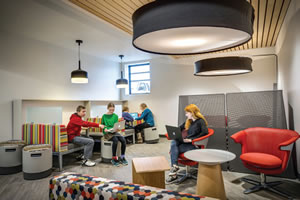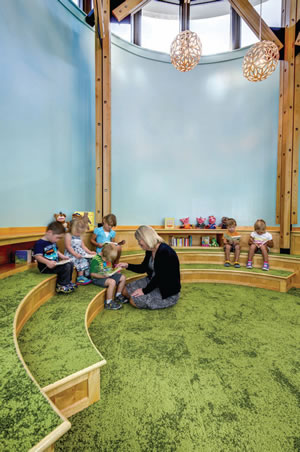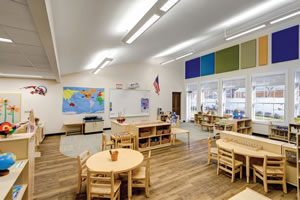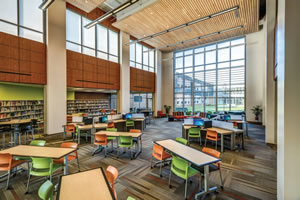School Lighting Design

PHOTOS COURTESY OF SHP LEADING DESIGN
Do you remember Super Bowl XLVII? Unless you are a rabid football fan, you probably don’t remember every moment of the game (in which the Baltimore Ravens beat the San Francisco 49ers, 34-31). There is one moment of this game that sticks in my mind, however: the moment the lights went out. Shortly after halftime, the 73,000-seat New Orleans Superdome was plunged into near-darkness when a piece of equipment monitoring the electrical load sensed an abnormality in the system and partially cut power to stadium. Suddenly, lighting was on America’s mind.
While schools don’t have to worry about a blackout affecting millions of people around the world, lighting is no less significant in the classroom — and on the budget sheet. Regardless of whether you are designing a new school, looking to reduce costs or improve lighting quality, lighting doesn’t have to break the bank. Here are a few tips for how you can reduce your school’s electric bill:
Occupancy Sensors
The easiest way to reduce energy costs is to turn off the lights when they are not in use. Most people do a good job of turning out the lights when they leave a room, but as those with young children at home know, not everyone can be counted on to flip the switch. Most building codes now mandate occupancy sensors to turn off all non-emergency lighting when a room is unoccupied. Occupancy sensors can be adjusted to turn off the lights after a time delay of 15 or 30 minutes of non-use. This time delay can be adjusted in the field to maximize energy savings.
Marrying Artificial Light with Natural Light
The next step to improve lighting in a school and reduce energy costs is to take advantage of the natural light provided by the sun. When planning for a new building, the very first thing we discuss with our school client is how the building can utilize the sun’s natural light to reduce costs. We determine the best orientation and optimal size for windows to maximize the advantage of the sun’s rays. We specify high efficiency multi-pane windows with better solar heat gain coefficient and lower U-factor. These higher-efficiency windows allow a balance between the additional natural light and heat transfer from the room to the outside. As an added bonus, many studies have shown that natural light improves both mood and performance in the classroom.

PHOTOS COURTESY OF SHP LEADING DESIGN
Under Control. Lighting control systems have improved. They now can be connected to a networked lighting control system that feeds information about the electricity usage of lighting fixtures for the entire school back to a central processor. This system takes into account the status lighting in each room to determine real-time energy savings. System-wide changes become easier, too; settings for occupancy and daylight sensors can be adjusted from the central processor instead of a technician manually resetting every single switch in the entire facility, saving both time and money.
Obviously, natural light isn’t always available at night, on cloudy days or shorter days in the winter, so schools must supplement with artificial light sources. Advances in control systems and lighting fixtures have made artificial lighting much more affordable and energy efficient.
For example, daylight harvesting, or varying the amount of artificial light based on the natural light that is available, is one practice that many schools have implemented. Sensors placed in the classroom measure natural light levels and automatically adjust the lights to meet a desired light level. As the sun gets stronger, the artificial lights gradually dim to maintain a consistent light level within the classroom. If a cloud passes overhead and blocks out the sun, the classroom lights automatically increase their output to again maintain the consistent light level. The brightening or dimming of the lights is typically so subtle that teachers and students rarely notice, but school administrators definitely notice the savings on their electric bill.
LED Versus Fluorescent
Another way schools can save money on their electric bill is by switching from fluorescent light fixtures to LED light fixtures. LED light fixtures are at least 10 to 15 percent more efficient than fluorescent fixtures and the LED light engines have a much longer lifespan, averaging 50,000-plus operational hours, compared to 25,000 to 35,000 operational hours for a fluorescent bulb.

PHOTOS COURTESY OF SHP LEADING DESIGN
Although prices for the newer technology have been coming down, LED light fixtures can be twice as expensive as fluorescent lights. To offset this cost, most utility companies have increased their rebate to almost 50 percent of the fixture cost to incentivize the use of LEDs. Between the newer utility rebates and decreased operational and maintenance cost, our life cycle cost analysis show paybacks in less than two to three years.
Another benefit of LED fixtures is that typically they are capable of being dimmed right out of the box. This is an improvement over the fluorescent fixtures that require more expensive dimming ballasts. Dimming is another energy saver for schools, in terms of both daylight harvesting as described above and manual dimming when teachers need to use a smartboard, AV system or projector. By providing a manual dimming system, it allows the teacher to tune the lighting system to meet the needs of a specific activity or to create a mood within the room.
Sensors and Systems
In the past, these lighting control enhancements have been hard to adjust. To adjust the time delay for an occupancy sensor or light level for a daylight sensor, contractors or building owners would have to visit each room and make adjustments at each sensor. This made it difficult to verify that all sensors have the correct adjustments.

PHOTOS COURTESY OF SHP LEADING DESIGN
Lighting control systems have been improved by integrating into a networked lighting control system that constantly feeds data about the electricity usage of lighting fixtures for the entire school back to a central processor. This system takes into account the status lighting in each room to determine real-time energy savings. The facility manager can receive real time updates on electricity usage instead of waiting for monthly electric bills or even a full calendar year to benchmark results. System-wide changes become easier, too; settings for occupancy and daylight sensors can be adjusted from the central processor instead of a technician manually resetting every single switch in the entire facility, saving both time and money.
What’s Next
One new lighting trend that we are keeping our eye on is the advent of color changing lights through LED technology. No longer relegated to decorating homes and trees during the holidays, color changing lights are advancing to deliver different moods — most notably interior rooms and special education classrooms.
For interior rooms with little or no windows, the lights could change from a warm yellow in the morning that reflects the early morning sun, to a brighter white around noon and then back to a yellowish hue in the late afternoon. These lights mimic the Circadian rhythm of the body and provide the optimal learning environment for students at various points throughout the day.
In special education classrooms, color-changing lights are being tested to gauge reactions to different colors. Students, particularly those with special needs, react differently to various colors, and it may prove that a green light is calming to one student while another prefers a blue or a purple light. If successful, this trend could have a tremendous impact on education environments, both K-12 and beyond.
As you can see from the examples above, improving lighting for schools doesn’t always require a large expense. By taking advantage of the sun’s natural light, LED lighting fixtures and lighting sensors and systems, schools can greatly reduce their electric bill, maintenance costs and improve the educational environment.
This article originally appeared in the issue of .